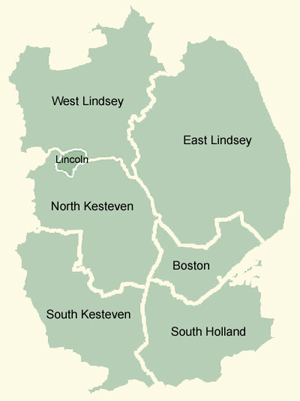Lincolnshire
Map of the Lincolnshire Area

County Council
- Lincolnshire County Council
- County Offices Newland Lincoln LN1 1YL
- http://www.lincolnshire.gov.uk/
Lincolnshire
Lincolnshire is one of England's largest counties with bustling market towns, welcoming beaches and historic sites. Major attractions include the Museum of Lincolnshire Life, the Battle of Britain Memorial Flight Visitor Centre, the Pink Pig Farm, and Lincoln Cathedral. The county has also been home to a number of artists, athletes and other notable figures, including former Prime Minister Margaret Thatcher, explorers Sir John Franklin and George Bass, Renaissance composer William Byrd, Oscar-winning actor Jim Broadbent, painter Frank Bramley, mathematician George Boole, and artists Peter De Wint and Frederick William Elwell.
The historic county of Lincolnshire borders Norfolk, Cambridgeshire, Rutland, Leicestershire, Nottinghamshire, South Yorkshire and the East riding of Yorkshire. Lincolnshire also borders Northamptonshire for just 18 metres, making it the shortest county boundary in England. Lincolnshire boosts a population approximately 1,042,000 and a population density of 150 people per square kilometre (390 per square mile), according to the 2011 Census. With an area of 6,959 square kilometres or 2,687 square miles, the ceremonial county of Lincolnshire is the second largest in England. The administrative county covers a smaller area of 5,921 square kilometres or 2,200 square miles, making it England's fourth largest administrative county.
Lincolnshire is divided into nine districts, including the two unitary authorities of North East Lincolnshire and North Lincolnshire along the Humber estuary. Other districts in the county include Lincoln, North Kesteven, South Kesteven, South Hollnad, Boston, East Lindsey and West Lindsey. The administrative centre of the county is historic Lincoln, which is also the county's major urban centre in addition to Boston. Other major towns include Grantham, Spalding and Gainsborough. Skegness, Ingoldmells and Chapel St. Leonards along the coast are also major population centres, in addition to Sutton-on-Sea and Mablethorpe.
The main economic activity in Lincolnshire is agriculture, although industry and service sectors are major employers in the county. Wheat, barley, sugar beet and oilseed rape are grown throughout the county, while potatoes, cabbage, cauliflower and onions are predominately grown in the south. Agriculture experiment stations are found in Sutton Bridge, where research focuses on Britain's potato industry. At the turn of the 20th century, Lincolnshire was also home to a number of engineering firms including Fosters of Lincoln and Richard Hornsby & Sons. Other major economic strengths include distribution and food processing, with tourism and high tech sectors emerging as areas of growth.
Transport
- Lincolnshire Public Transport
- http://www.lincsbus.info/
Banks and Building Societies
- The Investing site allows you to search for your local bank branch's location, opening hours and contact details in Lincolnshire.
- http://www.theinvestingsite.com/banks/lincolnshire
Media and Newspapers
- Lincolnshire Echo
- http://www.lincolnshireecho.co.uk/
Tourism - Official Site
- Visit Lincolnshire
- http://www.visitlincolnshire.com/
Museum
- Museum of Lincolnshire Life
- http://www.visitlincoln.com/things-to-do/museum-of-lincolnshire-life
University
- University of Lincoln
- Brayford Pool Lincoln LN6 7TS
- http://www.lincoln.ac.uk/
